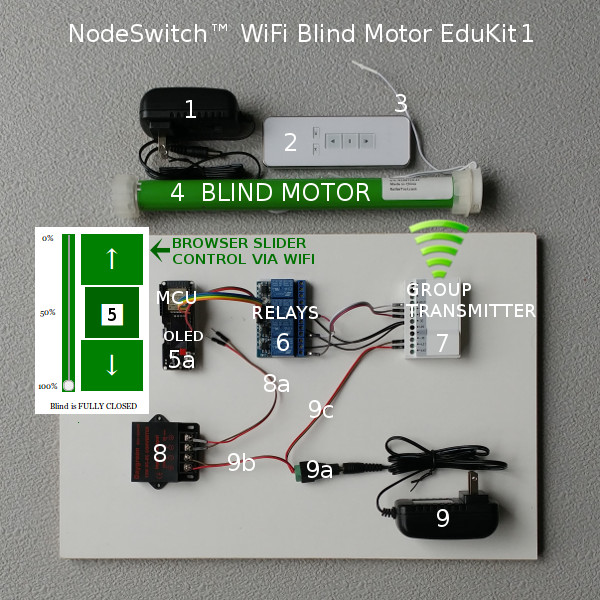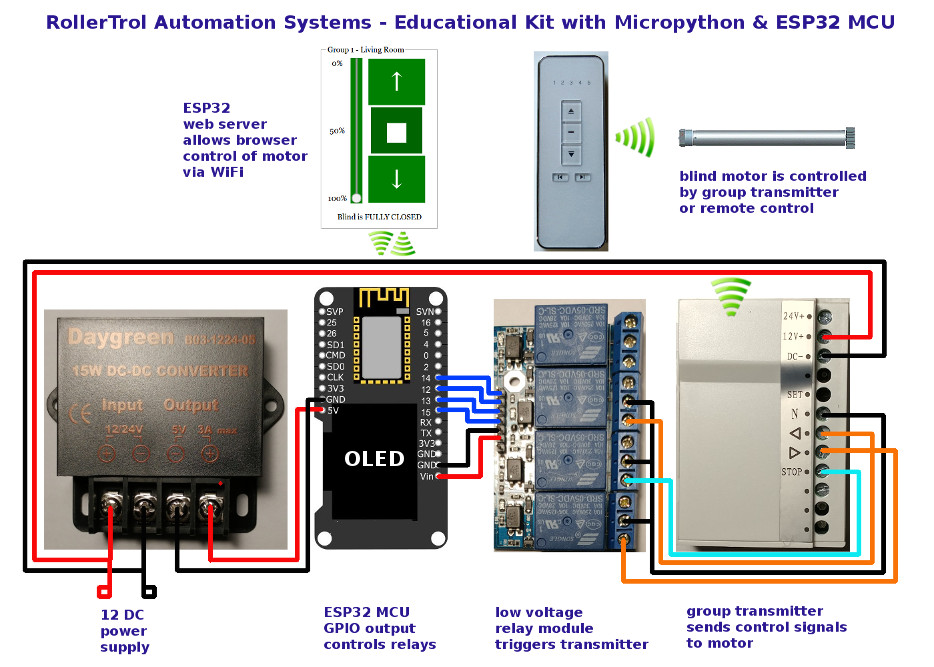WiFi Blind Motor Control: Educational Kit Components
Micropython is a powerful, compact subset of the Python v3 programming language used with the advanced ESP32 microcontroller from Espressif®. This unit is so fast it can go from a cold start to full internet connection in less than a second! It also has a deep sleep mode that consumes only 0.01 mA
We developed this educational kit so that you (or a geek in your family) can learn about this advanced system, with a very practical result of being able to control your blinds with any web enabled device (phone, tablet, laptop, etc). There is no soldering required for this kit (we pre-solder the headers).
You can use any browser in your home to adjust the slider and communicate via WiFi with the ESP32 microcontroller. This controls the relay module which triggers the group transmitter to send out the radio control signals to the blind motor.
ESP32 Blind Controller Component Layout
The backing board can be mounted in a closet or basement somewhere out of sight because the group transmitter can reach anywhere within a typical home. Here is a summary of the kit components:
 1. POWER SUPPLY: A 12V DC power supply (2 amp) provides power for the blind motor. Standby current of the motor is very low, about 70 microamps. The battery motor kit has an AC charger instead of this power supply.
1. POWER SUPPLY: A 12V DC power supply (2 amp) provides power for the blind motor. Standby current of the motor is very low, about 70 microamps. The battery motor kit has an AC charger instead of this power supply.
2. REMOTE CONTROL: Our standard 5 ch remote can reach motors mounted anywhere in a typical home; the radio signal will pass easily through most walls. This unit can be used to set the travel limits of 5 different motors.
3. RECEIVING ANTENNA: The antenna wire picks up the remote control signal from the 5 ch remote control or the group transmitter.
4. BLIND MOTOR: The radio motor can store 20 different channels, so you can have multiple hand held or wall mounted remotes. It also comes with mounting brackets; for more info, please see this comparison table of blind motors.
It slides into the tube of a roller shade, and you can make it yourself, or order pre-cut fabricated shades mounted on proper tubing from our custom shade division.
5. BROWSER CONTROL: The ESP32 microcontroller has powerful capabilities, including the ability to act as a web server, with browser control of the system.
Item 5 is a screen capture of the vertical slider control we designed, using the Micropython and Javascript programming languages. Please see part 5 of this article series for a working demonstration of the blind slider control.
5a. MICROCONTROLLER BOARD: The ESP32 microcontroller is mounted on a motherboard, with a built-in OLED display that is very handy for displaying system status and error messages that you will learn how to control. This board also has a standard plug and charging circuitry for a 3.7v lithium backup battery (not supplied).
We have installed special headers that accept plug-in dupont wire harnesses (provided), so there is no soldering required. These special headers also have legs protruding from the bottom, so you can use a breadboard, if you prefer.
We have also pre-loaded it with functional software, so you can use it out of the box, but it can be re-programmed via WiFi, or with a serial USB to micro cable (see Part 2 in this article series).
6. 4 CH RELAY MODULE: The ESP32 controls this four channel relay module to act as a trigger for the 3 actions of the group transmitter (OPEN/STOP/CLOSE). We provide a proper Dupont style of wiring harness that is used to connect the 3 data pins, ground pins, and 5 volt power to the relay module.
It uses one relay for each of the 3 actions, so there is one spare relay that can turn something else on (LED array?). The relays can handle up to 10 amps of current, which is much more than required for the group transmitter.
7. GROUP TRANSMITTER: Our group transmitter operates at 433 MHz, with a digital radio protocol that penetrates most walls. It is a single channel unit that can control an unlimited number of motors simultaneously. The dupont wiring harness (provided) connects it to the relay module. 12v power is supplied directly from the power supply (9c).
8. DC CONVERTER: This device is a buck converter that provides 5V power (for the MCU board and relay module) from the 12V power supply. It has a maximum output of 3 amps, which leaves a lot of headroom.
8a. 5V DC FEED: If you use a serial cable to program the MCU board, it will supply 5V power too. But once the device programming is over, you may want to mount the components in a closet, so this line can be used to power the MCU and relay boards.
9. 12V DC FEED: This 2 amp unit supplies power to the buck converter (9b) and group transmitter (9c) via the screw terminal adapter (9a) provided with the power supply.
ESP32 Blind Motor Wiring Diagram
Have you got a geek in your life? Please see the links at the bottom of this page for more info; here is a wiring diagram:

You can purchase educational kits for blinds and window openers, and our control products in our online DIY automation store.
Stay tuned, if you're interested; we are taking the journey into IoT and automation, writing about every step we take!
Adrian Biffen
Senior Partner
RollerTrol Automation Systems
We sincerely hope you enjoy our advanced technology products; if you have any questions, please contact us at any time!
Articles in this series:
Part 1: Micropython for the ESP32: Connecting to Your WiFi Router Network
Part 2: Micropython for the ESP32 Microcontroller: REPL Communications
Part 3: Micropython for the ESP32: FTP Fast File Transfer
Part 4: Micropython for the ESP32: Pre-loaded Programs
Part 5: Micropython for the ESP32: DC Motor Reversing Switch
Part 6: Micropython for the ESP32: WiFi Blind Motor Educational Kit Components (you are here)
Part 7: Micropython for the ESP32: Error Codes and Definitions

 Shopping Cart Home - Start Here
Shopping Cart Home - Start Here Z-Wave Motor Control
Z-Wave Motor Control Remote Controls for Radio Equipped Motors
Remote Controls for Radio Equipped Motors DIY Starter Kits for Window Shades
DIY Starter Kits for Window Shades DIY Starter Kits for Window Openers
DIY Starter Kits for Window Openers Alexa & Broadlink RM4 Pro Home Theater Control
Alexa & Broadlink RM4 Pro Home Theater Control Zwave Motor Control: Introduction
Zwave Motor Control: Introduction Shelly WiFi Wireless Motor Control
Shelly WiFi Wireless Motor Control Zigbee Motor Control (Under Development)
Zigbee Motor Control (Under Development) Raspberry Pi as a Home Automation Hub
Raspberry Pi as a Home Automation Hub Hubitat Elevation & Broadlink RM Pro Emitter
Hubitat Elevation & Broadlink RM Pro Emitter Blind Motors
Blind Motors Window Openers
Window Openers Skylight Openers
Skylight Openers Shade Slider
Shade Slider Curtain Closer
Curtain Closer Track Glider
Track Glider Background & Mission Statement
Background & Mission Statement Customer DIY Testimonials
Customer DIY Testimonials Contact Page
Contact Page